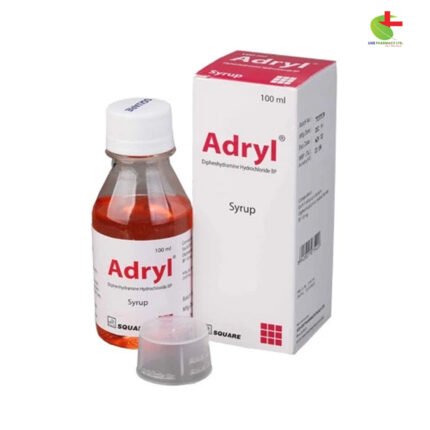Eromycin PFS
84.76৳ Pcs
- Unveil the comprehensive efficacy of Eromycin DS, a potent macrolide antibiotic.
- From upper respiratory tract infections like tonsillitis to skin and soft tissue infections including impetigo, Eromycin DS offers a broad spectrum of treatment.
- Its bacteriostatic or bactericidal action targets bacterial ribosomal protein synthesis, ensuring precise and effective therapy.
- Tailored dosages for different age groups guarantee safe and optimized treatment regimens.
- Trust Eromycin DS for thorough and reliable infection management.
 Brand
Brand
|
Square Pharmaceuticals PLC |
|---|---|
 Generics
Generics
|
Erythromycin |
 Type
Type
|
Suspension |
 Size
Size
|
100 ML |
Indications
Eromycin DS demonstrates exceptional efficacy in managing a diverse range of clinical infections, including but not limited to:
- Upper respiratory tract infections: Tonsillitis, Peritonsillar abscess, Pharyngitis, Laryngitis, Sinusitis. Additionally, it addresses secondary infections associated with colds and influenza.
- Lower respiratory tract infections: Tracheitis, Acute and chronic bronchitis.
- Ear infections: Otitis media, Otitis externa, Mastoiditis.
- Eye infections: Blepharitis, Established trachoma.
- Skin and soft tissue infections: Boils and carbuncles, Impetigo, Abscesses, Pustular acne, Paronychia, Cellulitis, Erysipelas.
- Gastrointestinal tract infections: Cholecystitis, Staphylococcal enterocolitis.
- Prophylaxis: Pre and post-operative, Trauma, Burns, Rheumatic fever.
- Other infections: Osteomyelitis, Diphtheria, Scarlet fever, Whooping cough.
Description
Eromycin DS, a member of the macrolides group of antibiotics, exhibits bacteriostatic or bactericidal action by interfering specifically with ribosomal protein synthesis within bacterial cells. Primarily utilized for infections caused by penicillinase-producing staphylococci, Eromycin DS targets various microorganisms, including Gram-positive and Gram-negative bacteria, mycoplasmas, and chlamydia.
Pharmacology
Erythromycin, the active ingredient, inhibits microsomal protein synthesis in susceptible organisms by impeding the translocation process. It shows specific binding to the 50S subunit or 70S ribosome in these organisms without binding to the stable 80S mammalian ribosome. Erythromycin demonstrates activity against numerous Gram-positive bacteria, some Gram-negative bacteria, mycoplasmas, and chlamydia.
Dosage & Administration
Dosage recommendations for Eromycin DS are as follows:
- Adults and children over 8 years: 250-500 mg every six hours for mild to moderate infections. In severe cases, this may be increased up to 4 gm or more daily.
- Elderly: No specific dosage recommendation. Erythromycin can be administered three times daily or twice daily by adjusting the total daily requirement accordingly.
- Children aged 2 to 8 years: 250 mg every six hours or 30-50 mg/kg body weight per day divided into four equal doses.
- Infants and children up to 2 years: 500 mg in divided doses or 30-50 mg/kg body weight in divided doses.
Interaction
Recent studies suggest that concurrent use of Eromycin DS with high doses of theophylline may elevate serum theophylline levels, potentially leading to theophylline toxicity. In such instances, the theophylline dosage should be adjusted accordingly.
Contraindications
Eromycin DS is contraindicated in individuals with known hypersensitivity to erythromycin.
Side Effects
Allergic reactions to Eromycin DS are rare and usually mild, though instances of anaphylaxis have been reported. Some patients may experience abdominal discomfort, nausea, or vomiting after oral administration, typically resolving without dosage adjustment.
Pregnancy & Lactation
While clinical and laboratory studies haven’t demonstrated human teratogenicity or toxicity, caution is advised when prescribing Eromycin DS to pregnant or lactating individuals due to its ability to cross the placental barrier and excretion in breast milk.
Precautions & Warnings
Exercise caution when administering Eromycin DS to patients with impaired hepatic function, as the drug is primarily excreted in bile.
Overdose Effects
In cases of overdose, discontinue Eromycin DS immediately. Prompt elimination of unabsorbed drug and appropriate supportive measures are recommended. Eromycin DS is not effectively removed by peritoneal dialysis or hemodialysis.
Therapeutic Class
Eromycin DS belongs to the therapeutic class of antimicrobial drugs, specifically macrolides, used in the management of infectious diarrhea.
Reconstitution
For suspension reconstitution, follow these directions: Shake the bottle to loosen the powder. Add 60 ml or 100 ml of boiled and cooled water to the dry powder in the bottle. For easier preparation, add water to the bottle in two portions. Shake well after each addition until all the powder is in suspension. Shake the suspension well before each use. Store the reconstituted suspension in a cool, dry place, preferably in the refrigerator, and discard any unused portion after 7 days.
Storage Conditions
Store Eromycin DS below 25°C, away from light and moisture, and out of the reach of children.













Reviews
There are no reviews yet.